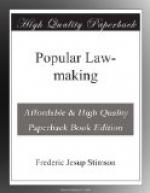the joint caucus and the separate caucus, the public
nomination paper, the one-per-cent., three-per-cent.
or five-per-cent. rule whereby a party gains such
official recognition only by throwing such a percentage
of votes at some previous election—in short,
all the mass of legislation of this kind is the matter
of the last few years. In the writer’s opinion,
with the possible exception of the public nomination
paper, it is all mistaken. Aimed at destroying
the machine, it really intrenches the machine—the
professional politician—in power. The
general public will not, and should not be compelled
to do more work than is necessary. If they actually
vote at election it is all that can fairly be asked
of them and more than one-third of them do. They
will not, and cannot, devote their time to politics
all through the year. The result is that all
such elaborate schemes simply throw the game into the
hands of the “town committee” or other
permanent professional body. If you have to hold
a meeting in June, and give notice of a caucus in July,
with as much formality as used to be required in publishing
the bans of marriage, and then on a certain day in
August do something else, and in September something
still more, and file with the Secretary of State nomination
papers in October, and have everything complete ten
days before election day,—the ordinary citizens
who usually awake to the fact that there is an election
about that time find it too late to have any voice
in the nomination. They go to the election itself
to find an official ballot with two machine candidates
for each office, and no hope of electing, even were
it possible to nominate, a third. In the old
days, when they discovered that an improper candidate
had been nominated, on the very eve of election they
could arouse themselves and defeat him; under all
these complicated systems it is too late. One
necessity for such legislation, however, arises from
the Australian ballot itself; when that ballot carries
party designations, who is to determine who is the
official party candidate? This problem is not,
however, insoluble. Indeed, it might be argued
that it would be an excellent test to require the
various so-called party nominees to run together,
leaving to the voter to determine who was the regular
one. Certainly the legalizing of conventions,
caucuses, and other nominating machinery, has led
to great scandals. Under such laws, whoever first
gets possession of the hall at the time named would
seem to be the regular candidate. We have, therefore,
in Massachusetts, seen the scandal of two groups of
men making different nominations in a loud voice at
the same time, one at the front of the hall, and the
other at the back, and the courts had to decide who
was the regular nominee. In the opinion of most
lawyers, they decided in favor of those who ought
to have been the nominees rather than of those who
in fact were.




